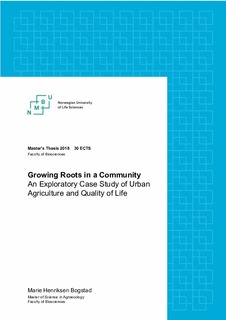| dc.description.abstract | In a world where an increasing number of people live in cities, urban health is an essential part of comprehending sustainable development. Thus, moving towards a more sustainable world both socially, economically and environmentally, to a large degree becomes an urban issue. Understanding health promotion, well-being and quality of life in urban areas, in terms of initiatives like for example urban agriculture, can be one way to merge sustainable development and health promotion. Urban agriculture (UA), or food production in the city, has in recent years had a renaissance among urban dwellers, politicians, and researchers.
The research at hand aimed to explore the relationship between urban agriculture participation and enhanced quality of life in an Oslo based community garden. The researcher approached this objective by using qualitative methods like photovoice, focus group and semi-structured interviews, and a phenomenological methodology. In doing so the research attempted to capture the rich experiences of the participants in the garden.
The researcher analyzed the data using conventional content analysis and came up with six categories for describing the relationship between the participants in the urban agriculture initiative and quality of life. These were: “Leisure time and recreation”, “Personal accomplishments and development”, “A social environment”, “An arena for family and friends”, “Belonging to the local community”, and “Impacts on bodily health”. All these categories highlighted the effects of participating in the urban agriculture project and can be understood as explaining a relationship between well-being and nature interaction, as well as social interaction and cohesion-building. These links can, in addition, be understood as attributing to both attention restoration, mending a ‘metabolic rift’, and developing a ‘sense of coherence’. They are similar to findings from previously conducted research on UA, in how they shed light on social relationships as an important benefit. However, they also highlighted the public health dimension of nature interaction in how natural environments, like urban agriculture, can contribute to increased well-being. Moreover, the goal of the research was to focus on the use of public spaces and provide further arguments for meaningful utilization of public green space. | nb_NO |

